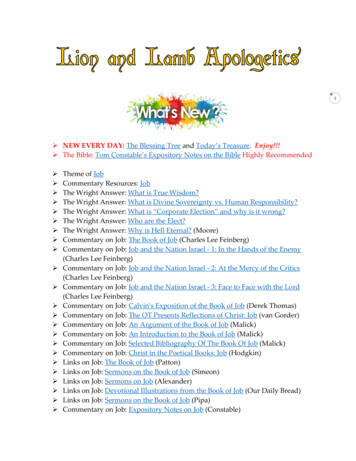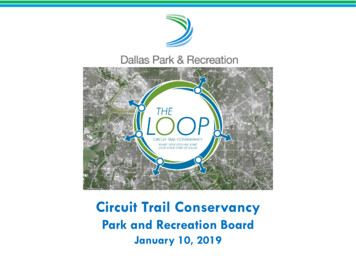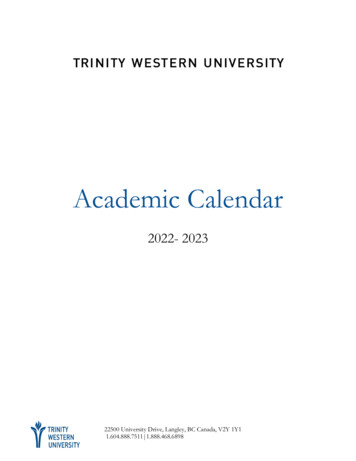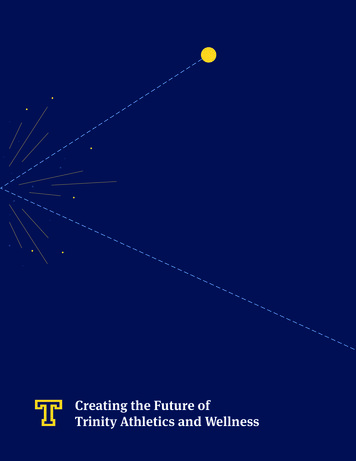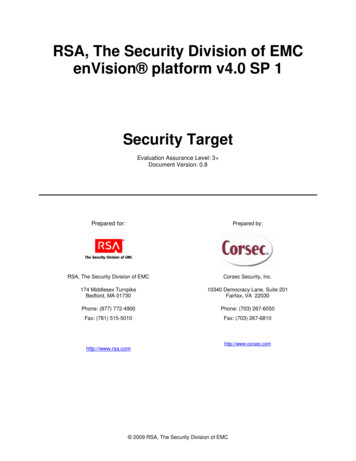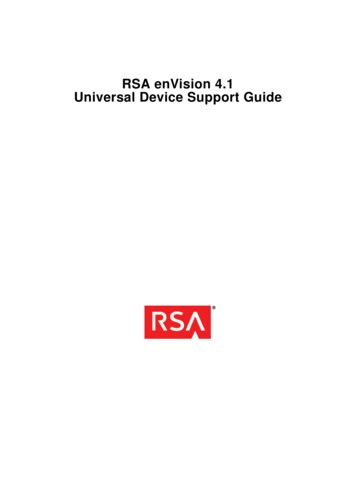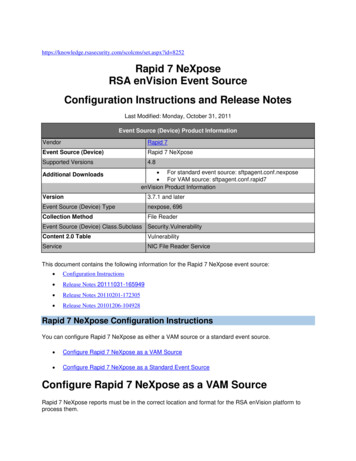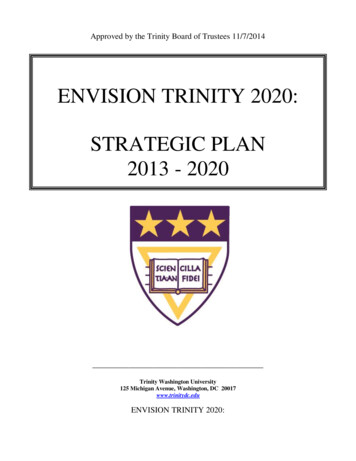
Transcription
Approved by the Trinity Board of Trustees 11/7/2014ENVISION TRINITY 2020:STRATEGIC PLAN2013 - 2020Trinity Washington University125 Michigan Avenue, Washington, DC 20017www.trinitydc.eduENVISION TRINITY 2020:
2STRATEGIC PLAN FOR THE PERIOD 2013 - 2020Envision Trinity 2020 continues the planning thread that began in the early 1990’s with TowardTrinity 2000, the plan that guided the 1996 Middle States self-study. In May 2000, the Board ofTrustees adopted a revised plan, Beyond Trinity 2000, that built upon the earlier plan’sstatements of vision and values, but with more measurable goals. At the time of the adoption ofBeyond Trinity 2000, Trinity also adopted a new mission statement, and reorganized into theuniversity structure with three academic schools. Beyond Trinity 2000 formed the basis forinstitutional assessment in the 2006 Middle States self-study. Following that accreditationmoment, Trinity revised the strategic plan to Achieving Trinity 2010, the plan that formed thebasis for a successful Periodic Review Report to Middle States in 2011.Continuing the same format as the three previous plans, and with the ongoing intention to use thestrategic plan as the platform for assessment and self-study, Envision Trinity 2020 updates thestatements of goals that flowed through the prior plans, and builds upon the same statement ofmission, providing the basis for the 2016 Middle States Self-Study.I. MISSIONTrinity’s Mission Statement confirms Trinity’s historic commitment to women, to liberallearning and to the Catholic faith tradition while articulating those commitments in new ways fornew student populations.Trinity Mission StatementTrinity is a comprehensive university offering a broad range of educational programs that prepare students across thelifespan for the intellectual, ethical and spiritual dimensions of contemporary work, civic and family life. Trinity’s coremission values and characteristics emphasize: Commitment to the Education of Women in a particular way through the design and pedagogy of thehistoric undergraduate women’s college, and by advancing principles of equity, justice and honor inthe education of women and men in all other programs; Foundation for Learning in the Liberal Arts through the curriculum design in all undergraduatedegree programs and through emphasis on the knowledge, skills and values of liberal learning in allgraduate and professional programs; Integration of Liberal Learning with Professional Preparation through applied and experientiallearning opportunities in all programs; Grounding in the mission of the Sisters of Notre Dame de Namur and the Catholic tradition,welcoming persons of all faiths, in order to achieve the larger purposes of learning in the humansearch for meaning and fulfillment.
3II. VISIONProceeding from mission, Trinity’s vision anticipates developing the institution as a mid-sizeduniversity (,more than 3,000 students including all degree levels, full-time and part-time, onlineand off-site as well as on campus) with a distinctive focus on the educational needs of thecitizens of the Washington region generally and the District of Columbia in particular. Given thecharacteristics of the Washington region, this regional focus is not narrow or parochial;Washington is one of the most international communities in the nation, and has a broad diversityof race, ethnicity, socio-economics, languages, cultures, corporate and civic interests.In particular, Trinity’s vision includes these important principles and values: A Value-Centered Education infused with the principles of social justice, honor andintegrity will continue to characterize Trinity’s learning environment and programs; Ensuring Access to Educational Opportunities will continue to arise from that socialjustice value center, such that Trinity will continue to develop its curricula and programsin ways that provide opportunities for educational attainment for students who mightotherwise not have had such opportunities to succeed academically; Respect for Human Dignity will continue to characterize Trinity’s campus life throughhonoring the broad diversity of races, ethnicities, cultures, languages, abilities, beliefsand interests of Trinity’s student body; Academic Excellence and Rigor will continue to characterize the expectations and workof the faculty with all student populations, with a clear focus on educational outcomesthat can demonstrate the quality and durability of a Trinity education through manydifferent occupations and life circumstances; Women’s Leadership Development will continue to be a distinctive characteristic of allTrinity educational programs; Education for Global Leadership will continue as Trinity’s theme to signify the globalperspective that Trinity expects its students and graduates to manifest in order to be trueleaders in contemporary communities, corporations, schools and public arenas; Service to Others will continue as a strong focus of Trinity’s programs and leadershipdevelopment philosophy; Educating Children Well will continue to be a particular emphasis of a Trinity education,not only in the School of Education but through all programs that lay the foundation forsuccessful teaching, parenting and role modeling for the next generations of citizenleaders.
4III. Environment, Assumptions, BenchmarksTrinity has developed the strategic plan Envision Trinity 2020 in an environment fraught withconsiderable challenge for institutions of higher education nationally and locally. At the outset,in 2013-2014, this planning document acknowledges these factors influencing the environmentfor higher education nationally and Trinity’s environment locally:National Environmental Factors Affecting Higher Education Broadly: Declining population of traditional-age students graduating from high schoolChanging demographics with dramatic rise in Hispanic populationIncreased demand for college access for low income studentsRegulatory pressures to improve retention and completion of college studentsExcessive federal regulation in all areasChanges in political landscapeStudent loan debt burdensPell Grant limitsNew competition: online, for-profit, “pop-up” degrees and other providersPopular media questioning value of collegeDemand for more accountability measured in salaries and employment of gradsIncreasing concern about U.S. competitive ability in STEM disciplinesImpact of sports on collegiate perceptions of traditional-age students and familiesGenerational change in faculty and university administrationLocal Environmental Factors Affecting Higher Education in the Washington Region: Washington region continues great wealth and high educational attainmentIncreased gap between rich and poor in the regionDistrict of Columbia literacy gapD.C. Public Schools educational gapLack of significant need-based aid for D.C. studentsThreats to D.C. TAGEnd of D.C. Achievers Grants (2017)Trinity takes these and other environmental factors into account in planning academic programs,enrollment and services to support enrollments, administrative capacity and improvements infacilities and technologies. The factors listed above influence Trinity’s choices in strategicplanning.
5A. AssumptionsTrinity has developed the goals of Envision Trinity 2000 with the following assumptions thatflow from the environmental factors as well as assessment of Trinity’s performance against goalsin the earlier strategic plans: Demand for higher education in the Washington region will remain strong but will focusmore acutely on diversified programs and degree levels leading to workforceadvancement in the key employment fields in the region; Demand for education and credentials in the Washington region will remain strong inthese particular fields:o health professions including direct services, mental health as well as physical,administration and education;o education of teachers and school leaders;o science disciplines especially those related to key areas of federal research andprivate investment, e.g., biotechnology, environmental, healtho nonprofit advocacy and leadership;o media including social media and broadcast, business and technical;o international affairs including politics, business and diplomacy;o education for the professional services industries that proliferate in Washingtonincluding law, financial services, hospitality and tourism, lobbying and advocacy; Trinity’s historic academic strengths and capacity are in general liberal arts and sciences,and those professional career fields that build on strong liberal learning foundations, e.g.,teacher and school leader education, health professions, general business; Trinity is unlikely to develop expertise in entirely new disciplinary fields where Trinitydoes not have core competencies, e.g., computer science, engineering; Trinity will remain focused on teaching, not research; Trinity will increase focus on graduate-level education in keeping with the desire of theWashington regional workforce to advance through levels of educational credentials; Trinity will evaluate the potential for offering degrees at the doctoral level where Trinityalready has proven competence at the baccalaureate and master’s levels; Trinity will enlarge capacity for online delivery but will remain primarily campus-based.
6B. BenchmarksFor many years, Trinity has developed benchmarks for performance using a cohort group ofsimilarly sized historic women’s colleges and Catholic women’s colleges in urban centers. Thecohort includes these schools:Alverno College, Milwaukee, WICarlow University, Pittsburgh, PACedar Crest College, Allentown, PAChatham University, Pittsburgh, PAChestnut Hill College, Philadelphia, PACollege of New Rochelle, New Rochelle, NYCollege of St. Benedict, St. Cloud, MNCollege of Saint Elizabeth, Morristown, NJEmmanuel College, Boston, MAHood College, Frederick, MDImmaculata University, Immaculata, PALesley University, Cambridge, MAManhattanville College, Purchase, NYMarymount Manhattan, New York, NYMarymount University, Arlington, VAMeredith College, Raleigh, NCMount Saint Mary’s, Los Angeles, CANotre Dame of Maryland University, Baltimore, MDRosemont College, Rosemont, PASage Colleges, Albany, NYSalem College, Winston-Salem, NCSimmons College, Boston, MAStevenson University, Stevenson, MDUniversity of Saint Joseph, West Hartford, CTUrsuline College, Pepper Pike, OHReferences to benchmarks throughout this planning document usually use benchmarks derivedfrom a cluster of all or some of these institutions unless otherwise noted.For over 10 years, Trinity conducted an extensive ratio analysis to assess the financial health ofthe institution. Trinity’s auditors BrownEdwards also provide critical financial indicators basedon the performance of their client group which includes some of the same institutions in Trinity’scohort. Effective 2014, Trinity adopted the same analysis as Brown Edwards but also added theperformance tracking of the 2014 bond covenants.
7IV. STRATEGIC GOALSArising from the Mission and Vision, Trinity articulates the following strategic goals forEnvision Trinity 2020. Strategic Goal 1: Enrollment DevelopmentBy the Year 2020 Trinity will enroll 3,300 students in degree programs as follows: 1,200 full-time undergraduate women students in the College of Arts and Sciences 500 graduate students in the School of Education 600 part-time undergraduate students in the School of Professional Studies; 500 graduate students in the School of Business and Graduate Studies; 500 undergraduate and graduate students in the School of Nursing and HealthProfessions.Appendix A: Enrollment includes the worksheets indicating how these enrollments will developover time.In order to achieve these goals, Trinity will create and will update periodically a five-yearoperational plan with specific annual goals and objectives that specify:o Strategies for enrollment of new students in each programo Strategies for retention of continuing studentso Strategies to improve completion ratesGoal 1: Key Performance Indicators:Reporting Cycle:Semester-by-Semester Progress Toward Goals StatedWkly Enrollment Reports; Final Semester Enrollments; Quarterly Board Reports
8 Strategic Goal 2: Financial PerformanceA. Financial Performance Goals:Trinity will continue to demonstrate superior progress in meeting or surpassing externallybenchmarked strategic financial ratios and critical financial indicators.Appendix B: Financial Indicators shows the baseline data for this goal.B. Fund Raising Goals:1. Annual FundTrinity’s Annual Fund performance will improve no less than 5% annually with a goal ofreaching 1.5 million by Fall 2020. To achieve this goal, the Annual Fund must also:a) improve alumnae percentage participation by 5% annually overall to achieve anultimate participation rate of 35% by 2020;b) improve participation in cohort groups as follows:(1) Overall CAS alumnae:(a) CAS alumnae pre-1990:(b) CAS alumnae post-1990:(2) Alumnae and Alumni in the professional schools:(a) SPS(b) EDU(c) BGS(d) NHPc) improve average gift sizes for each cohort.In order to achieve these goals Trinity will produce a five-year operating plan for the AnnualFund that will include more detailed planning and action steps for the organization of volunteersegments, affinity groups and reunion giving in keeping with contemporary best practices forimproving fund raising performance.2. Major and Capital GiftsTrinity will develop a five-year plan to build on the success of the Second Century Campaignthat will address ongoing development activities to build resources for scholarships, academicprograms, faculty support, technology and facilities infrastructure.Goal 2: Key Performance Indicators:Reporting Cycle:Quarterly Progress Toward Goals StatedQuarterly Board Reports
9 Strategic Goal 3: Program DevelopmentIn keeping with the results of self-study and market research, Trinity will develop its curriculaand programs to support the goals for enrollment growth as follows:Appendix C: Strategic Program Initiatives provides more detail for this goalo College of Arts and Sciences:a) Project Completion: a comprehensive approach to improving retention,persistence and timely degree completion through delivery of advising andsupport services aligned to student needs, risk factors and incentivesb) First Year Experience: a revised FYE program, based on assessment results ofthe existing FYE program, will improve first-to-second year retention from 54%in Fall 2013 in progressive increments to achieve 75% as a consistent target by2017 and hold or improve from that target by 2020c) Sciences: with the new academic center and participation in the Clare BootheLuce Program, Trinity will improve science enrollments significantly and toexpand the institutional reputation for excellence for women and minorities inMath and Science.d) International Affairs, Politics and Government: a comprehensive approach toenroll and support more International Affairs majors, through expansion ofcurricular opportunities, co-curricular and study abroade) Psychology, Human Relations, Behavioral Sciences and Business: currentlyamong the largest major programs, Trinity will continue to strengthen these keyprograms through innovative pedagogies and clear statements of outcomesincluding more intentional links to graduate and professional programs as well ascareer pathways.o School of Professional Studies:a) Undergraduate Business Administration(1) Accounting(2) Human Resource Management(3) Hospitality and Hotel Management(4) General Business Administrationb) Behavioral Sciences(1) Human Relations(2) Psychologyb) Education: Early Childhood Education
10c) Criminal Justiced) Media Studiese) Online and Off-site delivery of programso School of Business and Graduate Studies:This new academic unit will provide the administrative infrastructure and facultypersonnel necessary to achieve excellence in professional graduate programs, including:a) Masters in Business Administrationb) Master of Science in Administrationc) Media Studies and Strategic Communicationd) International Security Studieso School of Education:a) Early Childhood Education(1) Collaboration with SPS and CAS on undergraduate degrees(2) Strengthen MAT ECE focus(3) Add emphasis in EDAD on ECE managementb) Education Policyc) Counseling(1) CACREP Accreditationd) New regulatory and accreditation issues for teacher educatione) Online and off-siteo School of Nursing and Health Professions:a) Improving NCLEX performance in prelicensure programb) Expanding RN-BSN partnershipsc) MSNd) Occupational Therapy OTA and MSN build-oute) Online opportunitiesf) Other Allied HealthGoal 3: Key Performance Indicators:Reporting Cycle:Program Speed-to-Market; Achievement of Program Enrollment GoalsBiweekly Senior Staff and Dean’s Reports; Quarterly Board Reports
11 Strategic Goal 4: TechnologyTrinity will sustain a technological environment that promotes academic excellence andinnovation; effective, pervasive use of contemporary tools for research, communication andinstructional delivery; and operational efficiency and effectiveness.A. Technology InfrastructureTrinity’s technology infrastructure will meet contemporary standards for academic institutions ofTrinity’s size and programmatic profile. The technology management plan includes specificannual goals and benchmarks for:1.2.3.4.5.6.7.8.9.System ReliabilityNetwork CapacityHardware and Software acquisitionsData StorageDisaster er SatisfactionB. Academic and Instructional TechnologyTrinity’s academic and instructional technology environment will ensure excellence andinnovation in academic programs, pedagogies and research. The academic technologymanagement plan includes specific goals and benchmarks for:1. Moodle Course Management Systema) Goal: 95% adoption for all coursesb) Goal: proficiency levels for course websitesc) Goal: proficiency levels for faculty use of Moodle2. Technology in Pedagogya) Goal: basic, advanced, creative use of tech tools.b) Goal: ability of faculty to develop digital objects, e.g., use of video,simulation, GIFs, etc. developed by faculty3. Student Academic Supporta) use of tech tools for early warningb) tutoring and special instruction
124. Online Course and Program Deliverya) Hybridb) 100% online5. Library and Research ResourcesC. Data and Information Technology and AssessmentRecognizing that sustaining a culture of assessment requires strong data and informationtechnology, Trinity will build advanced capacity for data and information management across allinstitutional levels and programs in order to ensure the maximum use of assessment tools toinform institutional decisions and future initiatives.1. Institutional Research2. Management Capacity3. Academic Assessment CapacityD. Communications, Website and Social MediaTrinity will build and sustain an environment for excellence and effectiveness across allcommunication platforms including continuous development of Trinity’s main website andmaintenance of high standards for quality and engagement across numerous forms of socialmedia reaching members of the internal campus community as well as external audiences ofprospective students, alumnae/i, benefactors, employers and the general public.E. Faculty and Staff DevelopmentThrough the Trinity Institute and other professional development opportunities, Trinity willprovide education and training for all faculty and staff to make the best use of technological toolsand communications platforms in teaching, research and administrative services.Goal 4 Key Performance Indicators:Reporting Cycle:TBD in Tech Plans: Tech Services, Academic Tech, Library, WebsiteMonthly Management Reports; Quarterly Board Reports
13 Strategic Goal 5: Human Resource DevelopmentConsistent with Trinity’s enrollment goals and programmatic development expectations, Trinitywill develop its human resources to achieve the levels of performance quality in all areas that arenecessary for institutional success.A. Faculty Alignment of the size of the full-time and part-time faculty in each school to the size ofenrollments in programs, consistent with disciplinary standards and industry benchmarksfor program staffing; Hiring and promotion of a qualified diverse faculty body that reflect Trinity’s diversestudent population; Continuing improvement in full-time faculty compensation aligned with benchmarks; Creation of a compensation plan for adjunct faculty that recognizes and sustainsacademic talent; Development of a more comprehensive faculty development program to providecontinuous education in pedagogy, curriculum reform, classroom managementtechniques, research and scholarship, use of technological tools, and ongoing professionalenhancements for the faculty; Development of the Faculty Handbook policies in relation to contemporary realities forworkload, delivery systems, technological innovation and professional development.B. Staff Continuing development of the staff performance assessment system includingproduction of management data based on assessments that provide targets for staffdevelopment and compensation planning; Continuing development of the Trinity Institute staff professional development programsto improve staff knowledge, skills and competencies in supervision and management,technology and applications, teamwork and project planning, and related skill sets; Development of the Wage and Salary Plan to provide greater flexibility in the recognitionof staff performance tied to goals; Promotion of a climate for innovation and cross-functional teamwork among alladministrative departments, and with faculty, to improve Trinity’s ability to recruit andretain students successfully. Hiring and promotion of a qualified and diverse staff that reflects Trinity’s diversestudent population.Goal 5: Key Performance Indicators:Reporting Cycle:TBD: Academic Personnel Plan; Staff Development PlanWeekly Senior Staff Report; Quarterly Board Report
14 Strategic Goal 6: Management CapacityIn order to support the growth of programs and services that this plan requires to meet theenrollment and financial goals, Trinity must continue to develop its management capacity in allunits to ensure strategic success. Accordingly, Trinity will:o Create an institutional management design that provides sufficient talent to supportachievement of strategic goals in every department and programo With the leadership of each academic dean, a plan for the development of academicadvising and other services to support each academic unit will specify the additionalknowledge, skills and competencies necessary to manage the units successfully infulfillment of unit performance goals;o With the leadership of the senior executive staff, every subsidiary division anddepartment will specify in their annual plans the knowledge, skills and competenciesnecessary to manage each division and department successfully in fulfillment ofperformance goals;o Supervisors will receive ongoing education and training in management techniques toimprove their ability to focus on achievement of goals and objectives as well asprofessionally develop and lead their teams in the achievement of goals and objectives;o Senior managers and executives will also participate in ongoing education and training toimprove their ability to professionally develop supervisors, and lead the staff and facultyteams to fulfillment of all goals.Goal 6: Key Performance Indicators:Reporting Cycle:Unit Plans; Senior Management PlanBiweekly Senior Staff; Quarterly Board
15 Strategic Goal 7: Intellectual and Informational ResourcesAs a community of scholars with an emphasis on teaching, Trinity must pay close attention tothe ongoing climate for intellectual productivity and leadership in disciplinary and professionalarenas for both faculty and staff. The “teaching college” paradigm that Trinity cherishes shouldmanifest itself in a broad variety of scholarly and professional activities that will enhanceTrinity’s reputation while also contributing to the knowledge base --- at Trinity and in highereducation generally --- in all fields, and particularly with regard to the education of students whomirror Trinity’s profile. Trinity has the potential to make significant contributions toprogrammatic and pedagogical models throughout education at all levels. In this way, Trinityproduces as well as uses intellectual resources.Accordingly, Trinity will increase its attention to scholarly and professional productivity in theseways:o Using web-based tools, and on a voluntary contribution basis, establishment of aclearinghouse for faculty and staff access to the scholarly and professional developmentwork of colleagues, including works in progress as well as completed materials;o Creation of a more distinctive focus on the importance of active contributions to theknowledge base, including establishment of appropriate symbols to recognize and rewardexemplars --- prizes and awards, dinners and luncheons, lectures and displays, all focusedon ideas, papers, projects, publications and contributions of Trinity faculty and staff;o Identification of specific incentives to improve intellectual productivity, including grants,professional development funds, compensation recognition, and other forms of tangiblerecognition.Along with promoting the development of intellectual resources broadly, Trinity will alsoenhance institutional focus on the development of the informational resources necessary tosupport the teaching and learning enterprise.o With the leadership of the Provost and librarian, Trinity will develop a strategic plan forthe development of the Library and its resources.Goal 7: Key Performance Indicators:Reporting Cycle:Publications and Substantive Participation in External Professional GroupsContinuous on web; Semester Summary; Annual Report
16 Strategic Goal 8: Service to Students and the CommunityIn fulfillment of Trinity’s mission to educate students across the lifespan, Trinity will continue todevelop innovative educational services and programs for students enrolled at Trinity as well asfor citizens of the larger Washington community, including:o For the campus community, Trinity will create annual plans with measurable goals forservice delivery and effectiveness, and customer satisfaction, in these areas for all schoolsand programs: Academic AdvisingLearning Skills supportCareer ServicesDisability Support ServicesHealth ServicesCampus MinistryResidence LifeStudent GovernmentStudent ActivitiesStudent Financial ServicesRegistration ServicesFood ServiceBookstoreFacilities ServicesComplaint Managemento Trinity will extend its educational and service talent to children, families and adults inneighborhoods, schools, civic organizations and other locations in the District ofColumbia and the Washington Region. Trinity will develop a specific annual plan withmeasurable goals for institutional outreach.o Through the Trinity Center for Women and Girls in Sports, Trinity will continue to offerwellness, fitness, recreational, educational and athletics programs and services to thelarger Washington community as well as to the campus community; the annual plan forthe Trinity Center includes measurable goals for these services;Goal 8: Key Performance Indicators:Reporting Cycle:TBD According to Unit PlansWeekly Senior Staff; Annual Report; Board Quarterly
17 Strategic Goal 9: Quality, Outcomes and Key Performance IndicatorsThe quality of Trinity’s performance is a significant factor contributing to the achievement ofenrollment and financial goals. Hence, establishing goals for quality performance, stated asmeasurable outcomes, become an important part of institutional assessment.Each of the previous eight goals includes a box at the bottom to identify Key PerformanceIndicators, which are overall targets by which quality performance can be measured. The boxesalso indicate a timetable for reports to different groups on progress toward the goal. Consistentreporting of results on a regular timetable will enhance Trinity’s ability to focus on improvingoutcomes.Beyond the specific unit-by-unit and goal-by-goal statements of outcomes and key performanceindicators, Trinity will also establish overall institutional plans and quality goals in these areas:o Creation of a nationally-recognized First Year Program for the successful development offirst year students who present preparatory challenges at entrance;o Establishment of a model program for student learning outcomes assessment that linksgeneral education and major program goals effectively;o Development of an Enrollment Management model that focuses on improving retentionand completion rates through sophisticated analysis of and programming for factors thatpromote retention and completion and those that cause attrition and delays in theeducational timetable;o Implementation of a longitudinal assessment system that is able to track alumnae/ioutcomes over time and link those outcomes to specific curricular goals;o Creation of a service response system for all departments that improves Trinity’sreputation among all constituencies for the quality, timeliness and effectiveness of servicedelivery;o Promotion of a more vigorous public image for Trinity through more effective use ofmedia to report the accomplishments of faculty, students, staff and alumnae.Goal 9: Key Performance Indicators:Reporting Cycle:Establishment of Goals and External Benchmarks for PerformanceMonthly in Senior Staff Meeting; Quarterly Board; Annual Summary
18 Strategic Goal 10: Facilities and Campaign PlanningBy the Year 2020 Trinity will realize these facilities goals:o Trinity Academic Center Construction completed and building openo Library re-development plan in placeo Construction of new/renovated residential facilities will be underway;o Facilities upgrades for fir
2 STRATEGIC PLAN FOR THE PERIOD 2013 - 2020 Envision Trinity 2020 continues the planning thread that began in the early 1990's with Toward Trinity 2000, the plan that guided the 1996 Middle States self-study.In May 2000, the Board of Trustees adopted a revised plan, Beyond Trinity 2000, that built upon the earlier plan's statements of vision and values, but with more measurable goals.
